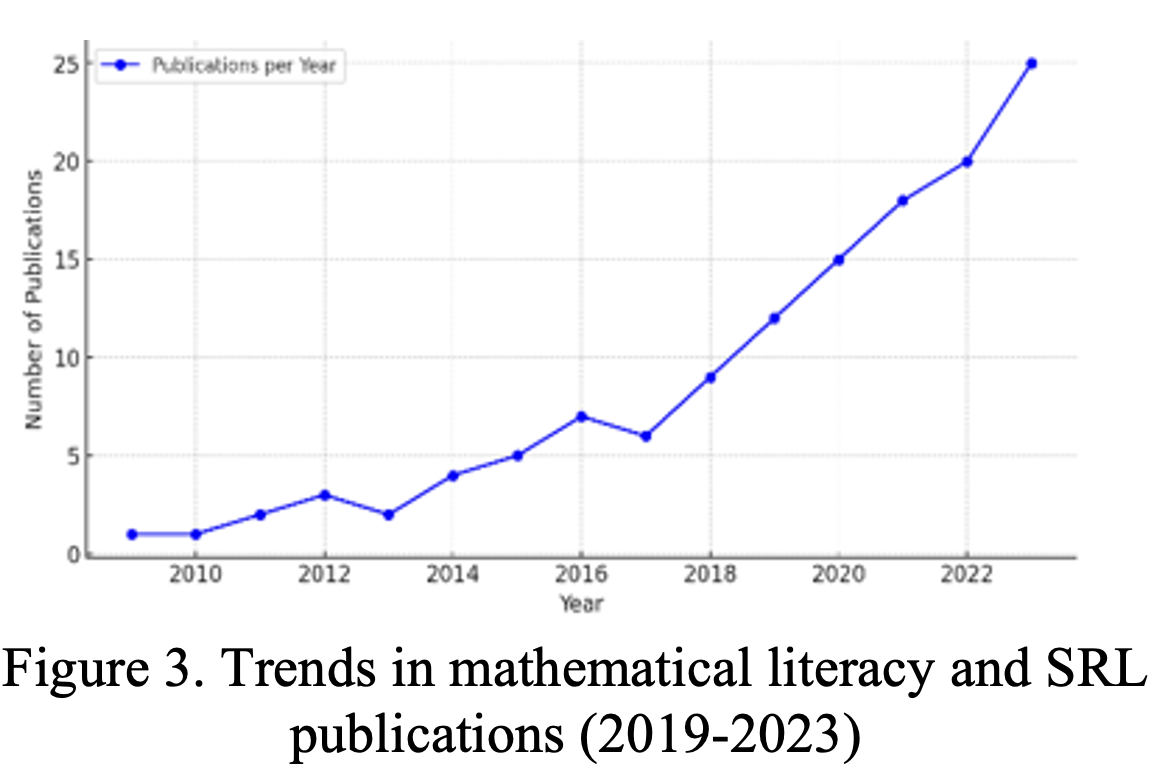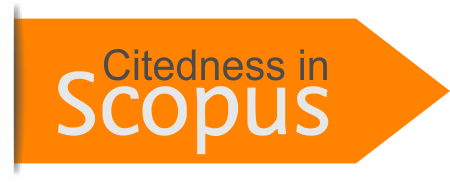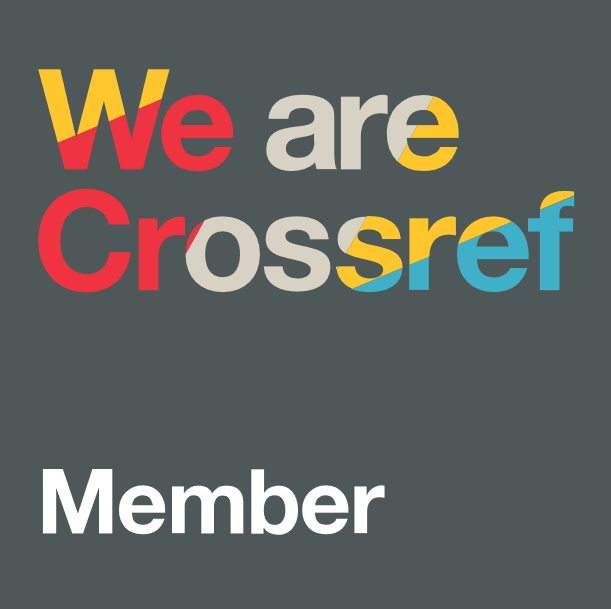Research trends in mathematical literacy and self-regulated learning: A scoping review using bibliometric analysis
DOI:
https://doi.org/10.31629/jg.v10i1.6916Keywords:
bibliometric analysis, mathematical literacy, metacognition, self-regulated learning, technology-enhanced learningAbstract
Mathematical literacy and self-regulated learning (SRL) are essential competencies for students' success in mathematics. However, research on their intersection remains fragmented, lacking a comprehensive overview of trends, key themes, and influential contributions. This study used Google Scholar and Publish or Perish to conduct a scoping review and bibliometric analysis of mathematical literacy and SRL research from 2009 to 2023. The analysis included publication trends, citation patterns, co-word analysis, and collaboration networks. The findings showed a significant increase in research after 2015, with peaks in publications in 2021 and 2022. Key themes include cognitive strategies, motivation, pedagogical approaches, technological integration, and assessment methods. The most cited works emphasize SRL's role in problem-solving, metacognition, and technology-enhanced learning. Collaboration networks indicate that research is dominated by North American, European, and Australian institutions, with limited contributions from developing regions. The study suggests expanding AI-enabled SRL research, teacher professional development, and culturally diverse frameworks to enhance mathematical literacy instruction globally. These insights contribute to advancing evidence-based instructional models that integrate Technology, self-regulation, and mathematical reasoning to improve learning outcomes.
Downloads
References
Aria, M., & Cuccurullo, C. (2017). Bibliometrix : An R-tool for comprehensive science mapping analysis. Journal of Informetrics, 11(4), 959–975. https://doi.org/10.1016/j.joi.2017.08.007
Arksey, H., & O'Malley, L. (2005). Scoping studies: Towards a methodological framework. International Journal of Social Research Methodology, 8(1), 19–32. https://doi.org/10.1080/1364557032000119616
Boekaerts, M. (1999). Self-regulated learning: where we are today. International Journal of Educational Research, 31(6), 445–457. https://doi.org/10.1016/S0883-0355(99)00014-2
Boekaerts, M., & Niemivirta, M. (2000). Self-regulated learning. In Handbook of Self-Regulation (pp. 417–450). Elsevier. https://doi.org/10.1016/B978-012109890-2/50042-1
Buchbinder, O., & McCrone, S. (2022). Guiding principles for teaching mathematics via reasoning and proving. https://hal.archives-ouvertes.fr/hal-03746878v2
Chen, X., Zhou, J., Wang, J., Wang, D., Liu, J., Shi, D., Yang, D., & Pan, Q. (2022). Visualizing status, hotspots, and future trends in mathematical literacy research via knowledge graph. Sustainability, 14(21), 13842. https://doi.org/10.3390/su142113842
Cheung, K. (2017). The effects of resilience in learning variables on mathematical literacy performance: A study of learning characteristics of the academic resilient and advantaged low achievers in Shanghai, Singapore, Hong Kong, Taiwan, and Korea. Educational Psychology, 37(8), 965–982. https://doi.org/10.1080/01443410.2016.1194372
Donthu, N., Kumar, S., Mukherjee, D., Pandey, N., & Lim, W. M. (2021). How to conduct a bibliometric analysis: An overview and guidelines. Journal of Business Research, 133. https://doi.org/10.1016/j.jbusres.2021.04.070
El-Adl, A., & Alkharusi, H. (2020). Relationships between self-regulated learning strategies, learning motivation and mathematics achievement. Cypriot Journal of Educational Sciences, 15(1), 104–111. https://doi.org/10.18844/cjes.v15i1.4461
Fuad, M., Suyanto, E., Sumarno, Muhammad, U. A., & Suparman. (2022). A Bibliometric analysis of technology-based foreign language learning during the covid-19 pandemic: Direction for Indonesia language learning. International Journal of Information and Education Technology. https://api.semanticscholar.org/CorpusID:251966174
Gabriel, F., Buckley, S., & Barthakur, A. (2020). The impact of mathematics anxiety on self-regulated learning and mathematical literacy. Australian Journal of Education, 64(3), 227–242. https://doi.org/10.1177/0004944120947881
Harding, S.-M., English, N., Nibali, N., Griffin, P., Graham, L., Alom, B., & Zhang, Z. (2019). Self-regulated learning as a predictor of mathematics and reading performance: A picture of students in Grades 5 to 8. Australian Journal of Education, 63(1), 74–97. https://doi.org/10.1177/0004944119830153
Kramarski, B. (2012). Stimulating self-regulated learning in hypermedia to support mathematical literacy of lower-achieving students. In Technology as a Support for Literacy Achievements for Children at Risk (pp. 157–169). Springer Netherlands. https://doi.org/10.1007/978-94-007-5119-4_10
Kramarski, B., & Mizrachi, N. (2006). Online discussion and self-regulated learning: Effects of instructional methods on mathematical literacy. The Journal of Educational Research, 99(4), 218–231. https://doi.org/10.3200/JOER.99.4.218-231
Losenno, K. M., Muis, K. R., Munzar, B., Denton, C. A., & Perry, N. E. (2020). The dynamic roles of cognitive reappraisal and self-regulated learning during mathematics problem solving: A mixed methods investigation. Contemporary Educational Psychology, 61, 101869. https://doi.org/10.1016/j.cedpsych.2020.101869
Moala, J, G., & Hunter, R. (2019). Developing mathematical resilience among diverse learners: Preliminary progress and problematics. Perth: MERGA.
Moos, D. C., & Ringdal, A. (2012). Self-regulated learning in the classroom: A literature review on the teacher’s role. Education Research International, 2012, 1–15. https://doi.org/10.1155/2012/423284
Muliawanti, S., & Badu Kusuma, A. (2021). Measuring mathematical literacy of space and shape content as 21st-century competency. Journal of Physics: Conference Series, 1778(1), 012032. https://doi.org/10.1088/1742-6596/1778/1/012032
OECD. (2023). OECD Economic Outlook, Volume 2023 Issue 1. OECD. https://doi.org/10.1787/ce188438-en
Özcan, Z. Ç. (2016). The relationship between mathematical problem-solving skills and self-regulated learning through homework behaviors, motivation, and metacognition. International Journal of Mathematical Education in Science and Technology, 47(3), 408–420. https://doi.org/10.1080/0020739X.2015.1080313
Panadero, E. (2017). A review of self-regulated learning: Six models and four directions for research. Frontiers in Psychology, 8. https://doi.org/10.3389/fpsyg.2017.00422
Pintrich, P. R., & Blazevski, J. L. (2004). Applications of a model of goal orientation and self-regulated learning to individuals with learning problems. In International review of research in mental retardation (Vol. 28, pp. 31-83). Academic Press.
Scristia, S., Dasari, D., & Herman, T. (2023). Sentiment analysis of prospective mathematics teacher on reasoning and proof questions using Naïve-Bayes classification. Jurnal Gantang, 8(2), 155–165. https://doi.org/10.31629/jg.v8i2.6591
Suyanto, E., Fuad, M., Antrakusuma, B., Suparman, S., & Shidiq, A, S. (2023). Exploring the research trends of technological literacy studies in education: A systematic review using bibliometric analysis. International Journal of Information and Education Technology, 13, 914–924. https://doi.org/10.18178/ijiet.2023.13.6.1887
Tricco, A. C., Lillie, E., Zarin, W., O'Brien, K. K., Colquhoun, H., Levac, D., ... & Straus, S. E. (2018). PRISMA extension for scoping reviews (PRISMA-ScR): checklist and explanation. Annals of internal medicine, 169(7), 467-473. https://doi.org/10.7326/M18-0850
Wang, Y., & Sperling, R. A. (2020, May). Characteristics of effective self-regulated learning interventions in mathematics classrooms: A systematic review. In Frontiers in Education (Vol. 5, p. 58). Frontiers Media SA. https://doi.org/10.3389/feduc.2020.00058

Downloads
Published
Issue
Section
License
Copyright (c) 2025 Jurnal Gantang

This work is licensed under a Creative Commons Attribution-NonCommercial-ShareAlike 4.0 International License.

















